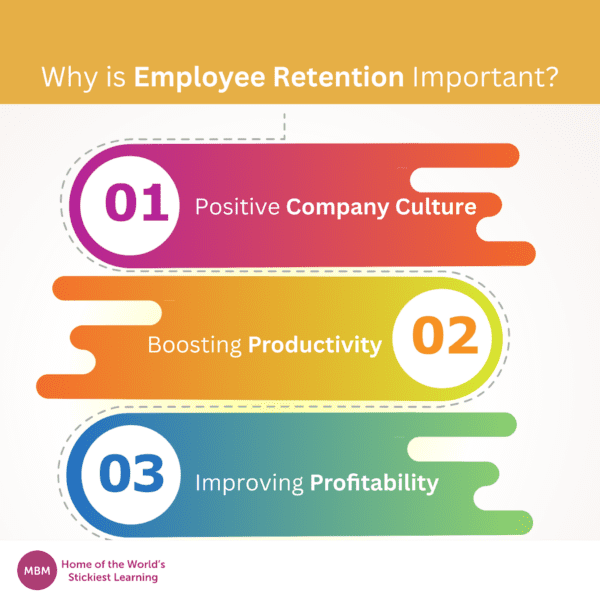Don’t Lose Your Most Important Asset — Your Top Employees!
Employee retention is a critical issue for organisations of all sizes, as it directly impacts their productivity, profitability, and overall success. Losing top-performing employees can be costly, not just in terms of time and money, but also in terms of decreased morale and disrupted team dynamics. As such, companies need to implement effective employee retention strategies to keep their valuable talent engaged and motivated.
In this article, we will explore the best practices for creating a positive work environment that encourages employee retention, from identifying key drivers of turnover to leveraging technology to measure the success of retention strategies.
Join us as we delve into the world of employee retention and discover how your organisation can attract and retain top talent for years to come.
Why is Employee Retention Important?
Employee retention is critical to any organisation’s success, as it impacts not just individual employees, but also company culture, productivity, and profitability. In today’s competitive job market, companies must prioritise retaining their top talent to remain competitive and thrive in their respective industries.

In this section, we will explore the importance of employee retention and why it matters for company success.
1. Creating a Positive Company Culture
One of the key benefits of employee retention is the creation of a positive company culture. When employees feel valued, supported, and invested in their roles, they are more likely to stay engaged and motivated, which can lead to improved teamwork, collaboration, and innovation. In contrast, a high turnover rate can negatively impact company culture, causing stress, burnout, and decreased morale among remaining employees.
2. Boosting Productivity
Employee retention also plays a crucial role in boosting company productivity. When employees stay with a company for a longer period, they become more familiar with the company’s processes, procedures, and culture, which can lead to increased efficiency and effectiveness. Additionally, employees who feel invested in their roles are more likely to go above and beyond in their work, taking on additional responsibilities and contributing to the overall success of the company.
3. Improving Profitability
Finally, employee retention is closely tied to company profitability. Losing top-performing employees can be costly, as companies must invest time and resources in recruiting, hiring, and training new employees to fill the gaps. Additionally, high turnover rates can lead to decreased productivity and lower-quality work, resulting in decreased revenue and profitability. By implementing effective employee retention strategies, companies can save money, improve productivity, and ultimately, boost their bottom line.
Identifying Factors Affecting Employee Retention: Understanding Key Drivers of Turnover
Employee retention is a critical aspect of any organisation’s success, as losing top-performing employees can be costly and disruptive to team dynamics. To create effective retention strategies, it’s essential to understand the key drivers of turnover.

In this section, we will examine the factors that influence employee retention, including job satisfaction, compensation, work-life balance, and career development.
1. Job Satisfaction
Job satisfaction is one of the most crucial factors affecting employee retention. Employees who are happy with their jobs are more likely to stay with the company longer. On the other hand, employees who are dissatisfied with their jobs are more likely to leave, leading to high turnover rates.
To improve job satisfaction, companies can focus on creating a positive work environment, providing opportunities for growth and development, and ensuring employees feel supported and valued.
2. Compensation
Another critical factor affecting employee retention is compensation. Employees who feel that they are underpaid or undervalued are more likely to look for opportunities elsewhere. Additionally, employees who feel that they are not receiving adequate benefits or perks may be more likely to leave for a company that offers more competitive compensation packages.
To improve retention rates, companies can offer competitive salaries and benefits packages and provide opportunities for bonuses and incentives.
3. Work-Life Balance
Work-life balance is another essential factor that impacts employee retention. Employees who feel that they have a healthy balance between work and personal life are more likely to stay with a company longer. In contrast, employees who feel that they are overworked or unable to take time off may be more likely to leave for a company that offers more flexibility.
To improve retention rates, companies can provide flexible schedules, offer remote work options, and ensure that employees have time for self-care and personal activities.
4. Career Development
Finally, career development is a crucial factor that influences employee retention. Employees who feel that they have opportunities for growth and development within their roles are more likely to stay with a company for a longer period.
To improve retention rates, companies can invest in employee training and development programs, provide opportunities for promotions and advancement, and ensure that employees have clear career paths within the company.
What Are Examples of Employee Retention Strategies?
Employee retention is a critical aspect of company success, and to retain top talent, organisations must develop effective retention strategies. In this section, we will highlight different retention strategies that companies can implement to retain their employees.

#1 – Employee Perks and Benefits
Employee perks and benefits are a critical aspect of any effective retention strategy. Offering perks and benefits can help create a positive work environment, increase employee satisfaction, and reduce employee turnover.
Companies can offer a wide range of perks and benefits, including health insurance, paid time off, flexible work arrangements, and employee discounts. By providing these benefits, companies can demonstrate their commitment to their employees’ well-being and foster a positive work culture.
#2 – Career Development Opportunities
Another critical retention strategy is to provide career development opportunities. Employees who feel that they have opportunities for growth and development within their roles are more likely to stay with a company for a more extended period.
Companies can offer a variety of career development opportunities, including training programs, mentorship, and promotions. By investing in employee growth, companies can demonstrate their commitment to their employee’s career development and foster a positive work culture.
#3 – Positive Work Culture
Creating a positive work culture is another effective retention strategy. A supportive and inclusive work environment can increase employee satisfaction, reduce turnover, and improve overall company performance.
Companies can create a positive work culture by promoting diversity and inclusion and fostering open communication and feedback.
#4 – Flexible Work Arrangements
Flexible work arrangements are another effective retention strategy that can help employees balance work and personal life. Companies can offer a variety of flexible work arrangements, including remote work, flexible schedules, and job sharing.
By offering these arrangements, companies can demonstrate their commitment to their employees’ well-being and improve overall job satisfaction. Additionally, flexible work arrangements can help companies attract top talent who prioritise work-life balance.
#5 – Recognition and Rewards Programs
Recognition and rewards programs are other critical aspect of employee retention strategies. Employees who feel appreciated and valued are more likely to remain with a company longer. Companies can implement recognition and rewards programs by acknowledging employee contributions, providing bonuses or incentives, and celebrating employee achievements. By recognising and rewarding employee efforts, companies can foster a positive work culture and increase employee satisfaction.
#6 – Flexible Benefits Packages
Flexible benefits packages are another effective retention strategy that can help employees tailor their benefits to their individual needs. Companies can offer a range of benefits, including health insurance, retirement plans, and paid time off, and allow employees to choose which benefits they want to use. By providing flexible benefits packages, companies can demonstrate their commitment to their employees’ well-being and increase employee satisfaction.
#7 – Employee Engagement Programs
Employee engagement programs are another critical aspect of retention strategies. Engaged employees are more likely to remain with a company for a longer period and are more productive and motivated.
Companies can implement employee engagement programs by encouraging employee participation in decision-making processes. By promoting employee engagement, companies can foster a positive work culture and increase employee retention rates.
#8 – Competitive Compensation Packages
Competitive compensation packages are another effective retention strategy that can attract and retain top talent. Companies can offer competitive salaries, bonuses, and other incentives to attract and retain the best employees. By providing competitive compensation packages, companies can demonstrate their commitment to their employees’ well-being and increase employee satisfaction.
Measuring the Success of Employee Retention Strategies
Measuring the success of employee retention strategies is essential for companies to determine the effectiveness of their retention efforts.
1. Defining Key Metrics
To measure the success of employee retention strategies, companies must define the key metrics to track. Some of the essential metrics to track include employee turnover rate, employee engagement, employee satisfaction, and productivity levels. By monitoring these metrics, companies can identify areas for improvement and determine the effectiveness of their retention efforts.
2. Calculating Employee Turnover Rate
Employee turnover rate is a critical metric for measuring the success of retention strategies. High turnover rates can be costly for companies, resulting in lost productivity, increased recruitment and training costs, and decreased employee morale. To calculate the employee turnover rate, companies can divide the number of employees who left the company by the average number of employees during a specific period.
3. Measuring Employee Engagement
Employee engagement is another critical metric for measuring the success of retention strategies. Engaged employees are more likely to remain with a company for a longer period and are more productive and motivated.
To measure employee engagement, companies can use surveys, focus groups, or other feedback mechanisms to gauge employee satisfaction, motivation, and commitment. By measuring employee engagement, companies can identify areas for improvement and take action to increase employee satisfaction and retention rates.
4. Assessing Productivity Levels
Productivity levels are another essential metric for measuring the success of retention strategies. High turnover rates can result in decreased productivity levels, which can impact company performance and profitability. By assessing productivity levels, companies can determine the effectiveness of their retention efforts and identify areas for improvement.
Additionally, companies can implement retention strategies that are designed to increase employee productivity, such as providing training and development opportunities.
Building a Diverse and Inclusive Workplace
Building a diverse and inclusive workplace is crucial for companies to attract and retain top talent.

Why do Diversity and Inclusion Matter?
A diverse and inclusive workplace can benefit companies in many ways. By hiring employees from different backgrounds and cultures, companies can increase creativity and innovation, enhance problem-solving skills, and gain a competitive edge in the marketplace. Additionally, an inclusive workplace can increase employee satisfaction and engagement, which can improve retention rates.
Creating a Culture of Inclusion
To build a diverse and inclusive workplace, companies must develop a culture of inclusion. This involves creating a work environment where employees feel valued and respected, regardless of their race, gender, age, or background. Companies can develop a culture of inclusion by implementing diversity and inclusion training programs and encouraging open communication.
Recruiting a Diverse Workforce
To build a diverse and inclusive workplace, companies must also focus on recruiting a diverse workforce. This involves creating job postings and recruitment strategies that attract candidates from diverse backgrounds and cultures. Companies can also partner with community organisations and professional associations to attract a more diverse pool of candidates.
Retaining a Diverse Workforce
To retain a diverse workforce, companies must create an inclusive environment where all employees feel valued and respected. This involves implementing policies and practices that promote diversity and inclusion, such as offering diversity training, providing flexible work arrangements, and recognising and rewarding employee contributions. By creating an inclusive environment, companies can improve employee satisfaction and retention rates, and attract top talent from diverse backgrounds.
Innovative Employee Retention Strategies
1. Online Training Programs
Online training programs can be an effective tool for improving employee development and retention. By offering online courses and certifications, companies can provide employees with the skills and knowledge they need to succeed in their roles and advance in their careers. This can improve employee engagement and retention rates. Employees are more likely to stay with a company that invests in their development.
Not sure where to look for effective training programs? Check out our soft skills training courses which also have online delivery options for you and your team.
2. Employee Engagement Platforms
Employee engagement platforms can also be a valuable tool for improving employee retention. These platforms allow employees to communicate with their managers and provide feedback on their job performance and workplace experiences. By providing employees with a platform to voice their opinions and concerns, companies can improve employee satisfaction and retention rates.
3. Artificial Intelligence
Artificial intelligence (AI) can be used to improve employee performance and satisfaction. For example, AI-powered chatbots can be used to answer employee questions and provide support, which can improve employee satisfaction and engagement. Additionally, AI-powered performance management systems can be used to provide employees with real-time feedback on their performance.
4. Flexible Work Arrangements
Flexible work arrangements, such as telecommuting and flexible schedules, can also be an effective tool for attracting and retaining top talent. By offering flexible work arrangements, companies can improve employee satisfaction and work-life balance, which can lead to increased retention rates. Additionally, flexible work arrangements can help companies attract a more diverse pool of candidates, as they allow employees to work from anywhere and at any time.
Succesful Case Studies
Let’s explore the best practices for employee retention previously mentioned by providing case studies and examples of successful companies with the best employee retention strategies and practices implemented.

1. Employee Recognition and Rewards Programs: The Power of Positive Reinforcement
Recognising and rewarding employees for their hard work and achievements can be a powerful tool for improving employee retention. Companies like Cisco have implemented successful employee recognition and rewards programs that have led to increased employee engagement and retention rates. For example, Cisco’s “Connected Recognition” program allows employees to recognise their peers for their contributions, which has led to a more positive work culture and improved retention rates.
2. Work-life Balance Programs: Prioritising Employee Well-being
Work-life balance programs can be an effective tool for improving employee retention. Companies like Hubspot have implemented successful work-life balance programs that have led to improved employee satisfaction and retention rates. For example, Hubspot offers flexible work arrangements, unlimited vacation time, and mental health days to its employees, which has led to a more engaged and satisfied workforce.
3. Career Development Opportunities: Investing in Employee Growth and Development
Investing in employee growth and development is a key strategy for improving employee retention. Companies like Salesforce have implemented successful career development programs that have led to improved employee satisfaction and retention rates. For example, Salesforce’s “Trailhead” program offers online courses and certifications to employees, which has led to improved skills and increased job satisfaction.
4. Mentoring and Coaching Programs: Providing Support and Guidance for Employees
Mentoring and coaching programs can also be effective in improving employee retention. Companies like Deloitte have implemented successful mentoring and coaching programs that have led to improved employee satisfaction and retention rates. For example, Deloitte’s “Career Connections” program matches employees with mentors who can provide guidance and support, which has led to improved employee engagement and retention rates.
Conclusion
In conclusion, employee retention is a critical aspect of company success, impacting company culture, productivity, and profitability. By prioritising employee retention, companies can create a positive work environment, boost productivity, and improve profitability.




